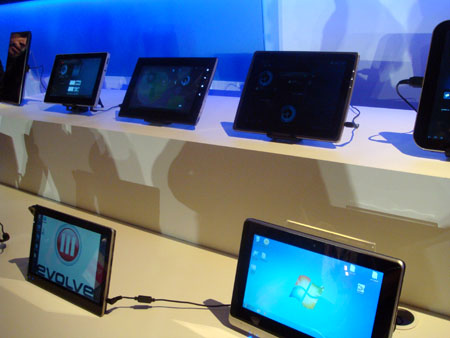Computex 2011: Intel's plan to tackle tablets

The rise of the tablet is part of a broader movement toward what Intel call companion computing, a category that includes all sort of personal and mobile devices from smartphones to netbooks to convertibles and sliders. In an event at Computex today Intel executives said companion computing was still in the early stages and discussed the strategy for getting Atom chips into these devices.
Intel believes that no one companion computing device will work for everyone and that there will be a lot of innovation in the hardware and software as companies developer different user experiences over the next 10 years. But it all "starts with the silicon," said Doug Davis, VP and GM of Netbook and Tablet Group.
Intel introduced Atom three year ago and it will ship its 100 millionth Atom SoC this month. But most of those have gone into netbooks and the vast majority of mobile devices use processors based on the ARM microarchitecture designed by companies such as Apple, Qualcomm, Samsung, Texas Instruments and Nvidia and manufactured by semiconductor foundries. Intel's strategy to break into tablets and smartphones is to leverage its lead in process technology and manufacturing.
Davis reiterated that for the next several years, Atom would scale at a faster rate than Moore's Law until it catches up with Intel's Core processors for PCs and servers. The first 32nm Atom SoCs will begin shipping in volume production later this year followed by 22nm Ivy Bridge versions in 2013. By 2014, Atom and Core will be aligned on 14nm.
"Intel gets this and we're investing in this space," Davis said. "We're accelerating our process technology roadmap."
But today Intel is still shipping several 45nm Atom SoCs. This includes the N series for netbooks. Intel demonstrated the Asus Eee PC X101, a 10-inch netbooks announced at Computex which uses an Atom processor and the MeeGo operating system and costs about $200. One of the first laptops to use Google's OS, Samsung's 12-inch Chromebook Series 5, has an Atom N570 dual-core processor.
Another 45nm SoC, the Atom Z670, or Oak Trail, was designed specifically for tablets. It has a smaller footprint and uses less power, but still has the performance for tasks such as 1080p video playback (as well as HDMI). At the Computex event, Intel showed a number of ODM (Original Device Manufacturer) designs-both "shipping systems and development platforms"-running Android 3.0 Honeycomb. Intel also demonstrated an interesting Fujitsu LifeBook slider and a Fujitsu Stylistic Windows slate for business.
Cedar Trail will also include several of what Intel is calling "Experience Features," which basically means additional features developed by Intel that involve software and hardware working closely together. Douglas listed six Experience Features including Intel Wireless Display, Smart Connect, Rapid Start, App Up, PC Synch and Ericsson 3G. Many of these are the same features that Intel has been demonstrating on its ultrabooks and other PCs.
Medfield is designed smartphones and tablets. Davis held up a silicon wafer containing Medfield SoCs as well as a reference design of a Medfield tablet running Honeycomb.
He said Medfield would be competitive with ARM-based SoCs in terms of power consumption "both standby as well as running various workloads" and will support Android and MeeGo tablets under 9mm thick and weighing less than 1.5 pounds. Davis also mentioned that Intel will ship a third 32nm Atom SoC, code-named Clover Trail, in 2012, but he offered no details. Ivy Bridge, which uses a new transistor design, will bring further improvements in performance and power, but Davis said it will also be highly tunable to meet the needs of a range of different devices.
Doug Fisher, Vice President of Intel's Software and Services Group, talked about the work the company has done to make multiple mobile operating systems including Android, Windows, Chrome OS and MeeGo work well on the x86 microarchitecture. To illustrate his, he showed three identical tablets running Honeycomb, Windows 7 and MeeGo. One of the tablets on display, the Evolve III, can even run all three and Fisher said there will be more of these multi-OS devices. Initially these will require a reboot to switch among operating systems, but this will be followed by virtualization solutions that will make this trick possible on the fly.
MeeGo has gotten off to a slow start, but Intel insist that there's real-demand for an open-source operating system that has consistent APIs that work across all devices and can be customized by hardware companies to differentiate their products. In addition to the Asus netbook, Fisher said more MeeGo devices were on the way including tablets, and MeeGo-based in-vehicle infotainment systems are already shipping. David Lee, Acer's Vice President of Mobile Computing, publicly demonstrated an Acer 10-inch tablet running MeeGo with an interesting custom task manager. He also talked about an Aspire One netbook with MeeGo, which Acer customized to provide its own user interface for social networking, and the Acer Chromebook, which uses an Atom SoC.
